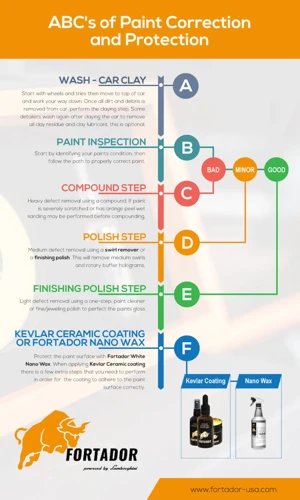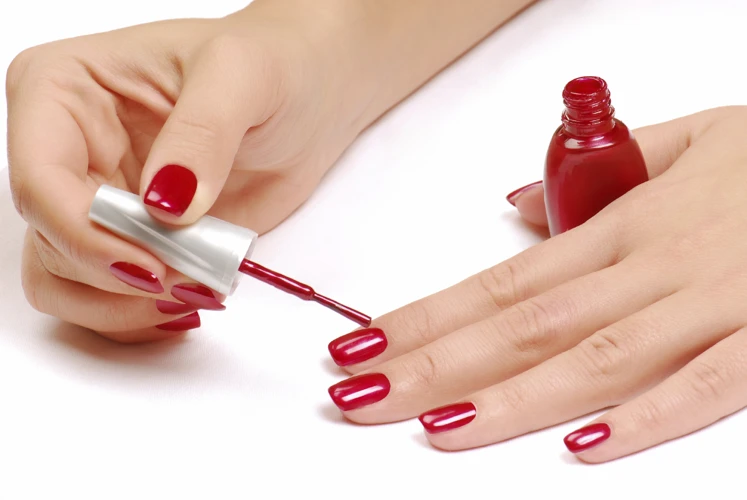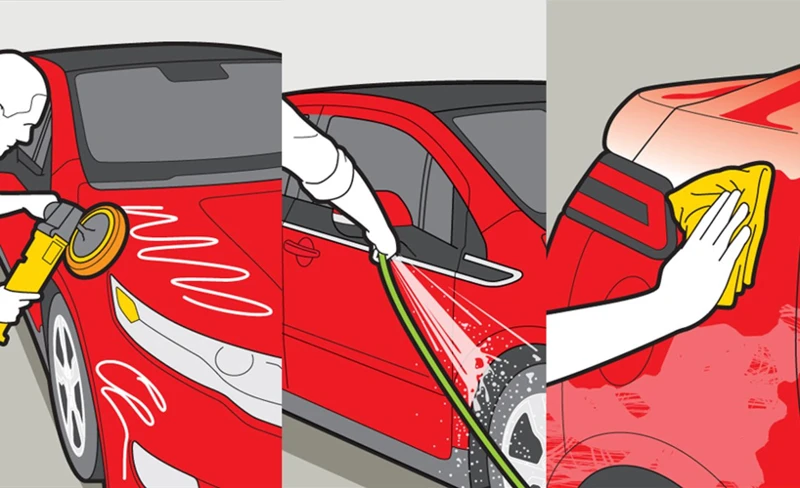A freshly painted surface can add a vibrant new look to any room or object. However, without proper maintenance, that new and shiny coating can fade or become damaged over time. This is where the importance of painted surface polish becomes evident. But with so many options available on the market, selecting the right polish may seem daunting. It is crucial to know your surface type and understand the ingredients in the product before making a purchase. In this article, we will provide you with step-by-step guidance on how to choose the right painted surface polish and how to master the technique of polishing like a pro. Whether you are a DIY enthusiast or a professional, follow our tips and tricks for a long-lasting and impressive shine.
Why Polish Matters

When it comes to maintaining the appearance of your painted surfaces, you may be wondering if using polish is really necessary or just an extra step. However, by skipping the use of polish on your painted surfaces, you may be missing out on a lot of benefits that could prolong its lifespan. In fact, using the right painted surface polish can help protect against scratches, fading, and other damage. So, what are these benefits of using polish and how do you choose the right one? Let’s find out.
Benefits of Using Polish
Using a painted surface polish can offer several benefits that improve the look and durability of your surfaces. Here are some advantages of using a good quality polish:
| Benefits of Using Polish |
|---|
| Enhances the shine and gloss of the surface, giving it a new-like appearance. |
| Protects the painted surface from UV rays, oxidation, and environmental damage. |
| Prevents the buildup of dust and grime, making cleaning easier. |
| Reduces the visibility of scratches and swirls on the surface, making it look smoother. |
| Improves the lifespan of the painted surface, reducing the need for frequent repairs or repainting. |
It’s important to note that the benefits of using a painted surface polish may vary depending on the type of surface and the type of polish used. It’s essential to select the right polish that meets the specific requirements of your painted surface. Understanding the types of painted surfaces and special considerations for each can help you choose the most suitable polish for your surfaces.
Types of Painted Surfaces

When it comes to choosing the right painted surface polish, it’s important to first understand the type of surface you’re dealing with. Not all painted surfaces are created equal, and some may have special considerations or require specific types of polish. Knowing which type of surface you have will help you make the best decision for achieving a long-lasting, high-quality shine. Whether you’re polishing the doors in your home, your car’s paint job, or your favorite piece of furniture, understanding your painted surface is the first step to success. To learn more about the different types of painted surfaces and how to choose the right polish, continue reading below.
Knowing Your Surface
Knowing your painted surface is crucial to choosing the right polish for maximum effectiveness. Here are some factors to consider:
- Type of Surface: Different painted surfaces require different types of polish. For example, a car’s painted surface requires a different polish than a painted wooden furniture.
- Age of Surface: The age of your painted surface will also impact your choice of polish. Older surfaces may require a more abrasive polish to remove scratches and restore shine, while newer surfaces may only require a gentle polish for maintenance.
- Condition of Surface: The condition of a surface is another important factor to consider. If the surface has deep scratches or damage, a polish may not be enough to restore it to its original condition.
- Surface Usage: The frequency of use of the surface should also be taken into account. For example, a surface that is frequently touched, such as doors or cabinets, may require a stronger polish to withstand wear and tear.
- Environmental Factors: The environmental factors that the painted surface is exposed to can also affect the choice of polish. For instance, a surface that is often exposed to the sun may require a polish with UV protection to prevent fading.
By taking these factors into consideration, you can choose the right painted surface polish that will be effective in restoring and maintaining the appearance of your surface.
Special Considerations
When it comes to choosing the right painted surface polish, there are some special considerations to keep in mind. Depending on the surface you are polishing and your specific needs, certain types of polish may be more beneficial than others. Here are some factors to consider:
| Special Considerations | Why It Matters |
|---|---|
| Type of Surface: | Different types of painted surfaces may require different polish formulations. For example, polishing a car requires a different type of polish than polishing a wood table. Be sure to choose a polish compatible with the surface you are working on. |
| Eco-Friendliness: | If using eco-friendly products is important to you, look for a painted surface polish that is environmentally friendly. Some polish formulations are made with natural ingredients and are free from harmful chemicals. |
| Frequency of Use: | If you plan on polishing your painted surfaces frequently, you may want to choose a lighter formulation that is gentle enough to use often without causing damage to the surface. |
| Scratches: | If your painted surface has scratches, you may want to choose a polish that is specifically formulated to remove scratches. Be sure to read the label carefully to ensure the polish is safe for use on the type of surface you have. |
| Polish vs. Wax: | It’s important to understand the difference between a painted surface polish and a wax. While both products can add shine and protection to painted surfaces, waxes are typically thicker and provide a longer-lasting protective layer. Polishes are lighter and can be used more frequently to maintain shine. Consider your specific needs when choosing between a polish and a wax. |
| Furniture: | If you are polishing painted furniture, you may want to choose a polish that is specifically formulated for use on wood surfaces. Some polishes can dry out wood and cause damage over time. |
By taking these special considerations into account, you’ll be better equipped to choose the right painted surface polish for your needs. Don’t forget to read the label carefully and follow the manufacturer’s instructions for best results.
Choosing the Right Polish

When it comes to polishing painted surfaces, choosing the right polish is crucial in achieving the desired results. With so many polishes available in the market, it may be perplexing to select one that is suitable for your surface. The wrong choice may lead to damage or ineffective polishing. In this section, we’ll discuss the factors to consider when choosing the right painted surface polish. We’ll also highlight the ingredients to avoid and look for in a polish. Whether you’re polishing furniture, cars, or doors, this guide will help you make an informed decision. So, let’s get started. And if you’re interested in learning more about the benefits of using painted surface polish, check out our previous section.
Ingredients to Look For
When it comes to selecting a polish for your painted surfaces, it’s important to pay attention to the ingredients that are listed on the label. Here are some ingredients to look for when choosing the right painted surface polish:
| Ingredient | What it does |
|---|---|
| Carnauba wax | This ingredient is derived from palm trees and is known for its ability to create a high-gloss shine. It is also water-resistant and provides a protective barrier against the elements. |
| Microfiber cloth | Although not technically an ingredient in the polish, using a microfiber cloth to apply and buff the polish will help to prevent scratching on the painted surface. |
| UV protection | If your painted surface will be exposed to the sun, then look for a polish that contains UV protection. Without it, the sun’s rays can cause fading and damage to the paint. |
| Acrylic resin | This ingredient helps to seal and protect the paint from scratches, swirls, and other types of damage. It also adds shine and depth to the color of the paint. |
| Natural oils | Oils like jojoba or coconut can be used to nourish, moisturize, and protect painted surfaces. They are also environmentally friendly and won’t harm the surface. |
When selecting a polish, be sure to check the label carefully to ensure that it contains these types of ingredients for the best results. If you’re unsure about which brand to choose, check out our review of the best painted surface polishes for furniture for some recommendations.
Ingredients to Avoid
When choosing a painted surface polish, it’s not just about the ingredients to look for. It’s important to know which ingredients to avoid as well in order to ensure that you don’t unintentionally damage your painted surfaces.
| Ingredient | Why to Avoid |
| Acidic solutions | Can damage the paint and make it more susceptible to chipping and scratching over time. Also, acidic products can corrode metals, and if used on any surface that has metal components or trims, it can cause discoloration and damage. |
| Alcohol-based solutions | Alcohol can dissolve or soften the paint, leaving it exposed to external elements and increasing the risk of peeling and cracking. It can also damage rubberized and plastic elements, making them brittle and prone to cracking. |
| Cheap and harsh abrasives | Abrasive compounds or harsh chemicals can scratch or wear away the clear coat or paint, creating swirl marks or taking off the color shine. It is crucial to select a polishing compound that has moderate abrasive properties suitable for your type of paint and to use proper tools to apply it evenly. |
| Silicon-based waxes | Silicon can leave waxy residues that can accumulate over time and create a hazy or clouded effect. It can also interact with other elements, such as dirt or moisture, and form a hard-to-remove film on top of the paint. |
| Ammonia-based products | Like alcohol, products containing ammonia can weaken the paint, eventually stripping it off or eroding the topcoat. They can also damage plastic, vinyl and rubber in your vehicle’s interior and exterior. |
These ingredients can create more harm than good for your painted surfaces, resulting in an uneven finish, ultimately leading to costly repair work. Always read the ingredients on any polish you buy and make sure they do not include any damaging chemicals.
How to Polish Like a Pro

As you may know, using the right polish can make all the difference in achieving a flawless finish on your painted surfaces. Knowing the proper technique and tools to use can also be a game-changer. In this section, we’ll share some tips and tricks on how to polish like a pro, so you can achieve the best results possible. Whether you want to remove scratches from your painted surfaces, achieve maximum shine, or just learn how to maintain your polished surfaces for a long-lasting result, we’ve got you covered. So let’s dive in and learn how to make your painted surfaces look their best! Don’t forget to check out our DIY painted polishing guide too for more information on this topic.
Preparation
When it comes to preparing your painted surface for polishing, there are a few essential steps you should follow:
- Wash the surface: Before applying any polish, it’s crucial to wash the surface thoroughly to remove any dirt, grime, or debris that may scratch or damage it. Use a gentle soap and warm water and rinse it thoroughly.
- Dry it off: After washing, the surface should be dried off completely with a microfiber towel to avoid any water spots or streaks.
- Check for scratches: Inspect the surface carefully for any scratches or damage that may need to be treated. In case you find any scratches, use a scratch remover along with the polish for a better result. For more information on removing scratches using polish, check out our guide to removing scratches using polish.
- Choose the right polish: Ensure that you have chosen the right polished surface by identifying the surface and selecting the appropriate polish. For more information on choosing the right polish, check out our guide to painted surface polish Vs wax.
By following this preparation process, you’ll be able to lay the foundation for a smooth and polished surface. Additionally, it’s essential to keep in mind that the frequency of polishing your painted surface varies based on the type of surface and the environment in which it is located. For more information on how often you should polish your painted surface, check out our guide to polishing painted surfaces frequency.
Technique and Tools
When it comes to polishing painted surfaces, there are a few techniques and tools that can make the job easier and more effective. Here are some tips to follow:
- Use a microfiber cloth: Microfiber cloths are gentle on painted surfaces and don’t leave behind lint or scratches. Use a clean, dry microfiber cloth to apply and buff the polish.
- Apply the polish in a circular motion: Apply the polish to a small section of the surface and use circular motions to work it in. This will help ensure even coverage and prevent streaks.
- Apply light pressure: Don’t press too hard when applying the polish or buffing the surface. Light pressure is all that’s needed to get the desired shine.
- Work in small sections: To prevent the polish from drying out before you have a chance to buff it, work in small sections of the surface at a time.
- Use a dual-action polisher: If you have a large surface to polish, consider using a dual-action polisher. This tool can help you cover more surface area in less time and can be especially useful for rough or textured surfaces.
By using these techniques and tools, you can achieve a smooth and shiny finish on your painted surfaces. However, be sure to follow the instructions on your chosen polish product and avoid using it on surfaces that are not recommended by the manufacturer. Additionally, consider using an eco-friendly paint polish to minimize your impact on the environment.
Cleaning Up
After polishing your painted surfaces, it’s important to clean up properly to avoid any damage or buildup of old product. Here are some steps to follow:
- Remove any excess polish: Use a clean microfiber towel to wipe away any remaining polish. This will prevent build-up and help to maintain a smooth finish.
- Wash the surface: Once the excess polish has been removed, use a gentle car wash soap to wash the surface. This will help to remove any remaining dirt, grime, or residues that may have accumulated on the surface.
- Use distilled water: It’s best to avoid using tap water as it can contain minerals that can damage your surface. Instead, use distilled water to rinse off the soap and any remaining residue.
- Dry with a clean towel: After rinsing, dry the surface with a clean microfiber towel. Avoid using any rough or abrasive towels that can scratch the surface.
Remember, improper cleaning can undo all of your hard work and cause damage to your painted surfaces. Take the time to clean up properly to maintain a long-lasting shine.
Also, be sure to avoid polished surfaces as they can be slippery and dangerous to walk on.
Maintaining Your Painted Surfaces
Now that you’ve achieved the perfect shine on your painted surfaces, it’s important to maintain them properly to ensure long-lasting results. Neglecting the upkeep of your surfaces can lead to discolouration, scratches, and a dull appearance. To avoid this from happening, there are a few tips and tricks you can follow to keep your painted surfaces looking their best. From using the right cleaning products to adopting the correct techniques, this section will provide you with all the necessary information you need to maintain your surfaces. So, let’s get started to keep your painted surfaces shining bright like new for years to come!
Tips and Tricks for Long-lasting Shine
After you’ve chosen the right painted surface polish and learned how to apply it properly, you’ll want to keep your surfaces looking their best for as long as possible. Here are some tips and tricks for achieving a long-lasting shine:
- Wash your painted surfaces regularly with a pH-neutral soap and water, and dry them with a clean microfiber towel. This will help remove any dirt or debris that can scratch the surface or dull the shine over time.
- Avoid parking under trees or areas where bird droppings are common. These can etch into the paint and create spots that are difficult to remove.
- Protect your car from UV rays by keeping it in a garage or using a car cover. Sunlight can cause your paint to fade or become discolored over time.
- Use a quick detailer in between washes to help maintain the shine and protect the surface from dust and dirt.
- Don’t use abrasive cleaners or tools like steel wool or rough sponges on your painted surfaces. These can scratch the surface and damage the paint.
- Consider getting a ceramic coating for your painted surfaces. These products provide long-lasting protection and can help your car retain its shine for years to come.
By following these simple tips and tricks, you can help ensure that your painted surfaces stay looking great for years to come. However, it’s important to note that some surfaces should be avoided altogether when it comes to polishing. Check out our article on surfaces to avoid polishing for more information.
Conclusion
In conclusion, choosing the right painted surface polish is essential to maintain the appearance and longevity of your painted surfaces. It is important to know your surface and any special considerations before selecting a polish. Look for polishes that contain high-quality ingredients, such as carnauba wax or polymer technology, as these will provide better results and protect the paint from damage. It is also crucial to avoid polishes that contain abrasive ingredients, such as silicone or ammonia, which can scratch or dull the surface.
Polishing like a pro requires proper preparation, technique, and tools. Always clean the surface thoroughly before polishing and use a clean, soft cloth to apply the polish. Work in small sections and use even pressure to apply the polish, then use a separate clean cloth to buff and remove excess polish. Remember to clean up any residue left behind to avoid stains or streaks.
Finally, maintaining your painted surfaces requires regular care and attention. Keep them clean and protect them from environmental factors such as UV rays and harsh weather conditions. Consider using a protective coating or sealant to extend the lifespan of your paint job.
By following the tips and tricks outlined in this article, you can achieve a long-lasting shine for your painted surfaces while avoiding damage or deterioration. Investing in the right polish and proper care will keep your surfaces looking new and fresh for years to come. So, go ahead and give your surfaces a much-needed makeover today!
Frequently Asked Questions
What is painted surface polish?
Painted surface polish is a product designed to clean, protect, and enhance the shine of painted surfaces such as cars, boats, and furniture.
Why should I polish my painted surfaces?
Polishing your painted surfaces helps to protect them from environmental damage, such as UV rays and acid rain, while also restoring their shine and creating a protective barrier against pollutants and dirt.
What types of painted surfaces can be polished?
Almost any painted surface can be polished, including cars, boats, furniture, and even walls. However, it’s important to know the type of surface you’re dealing with before choosing a polish product.
What are the benefits of using a polish product?
Polish products can help to restore the shine of painted surfaces, protect them against environmental damage, prevent oxidation and corrosion, and make surfaces easier to clean and maintain.
What should I look for in a painted surface polish?
When choosing a polish product, look for ingredients such as carnauba wax, polymers, and silicone that will protect and enhance the shine of your painted surfaces.
What ingredients should I avoid in a painted surface polish?
Avoid polish products that contain petroleum distillates, ammonia, or harsh solvents, as these can damage the painted surface or strip away the existing protective layer.
What preparations should I make before polishing my painted surfaces?
Clean the surface thoroughly, removing any dirt or debris, and make sure the surface is dry before applying the polish. Apply the polish in a shaded area, away from direct sunlight, and use a clean, dry applicator pad to distribute the polish evenly.
What techniques and tools should I use when polishing my painted surfaces?
Apply the polish in a circular motion, using moderate pressure, and work in small sections at a time. Use a buffing pad or microfiber towel to remove the excess polish, and switch to a clean applicator pad for each new section.
How do I maintain the shine of my painted surfaces?
Wash your painted surfaces regularly with a gentle soap and water, and avoid parking or storing your vehicle or furniture in direct sunlight for extended periods of time. Apply a new coat of polish every few months to maintain the protective barrier.
Can I use the same polish product on different types of painted surfaces?
It’s important to choose a polish product that is specifically designed for the type of painted surface you are working with, as different surfaces may require different levels of protection and shine. Make sure to read the label and choose the right product for your needs.
